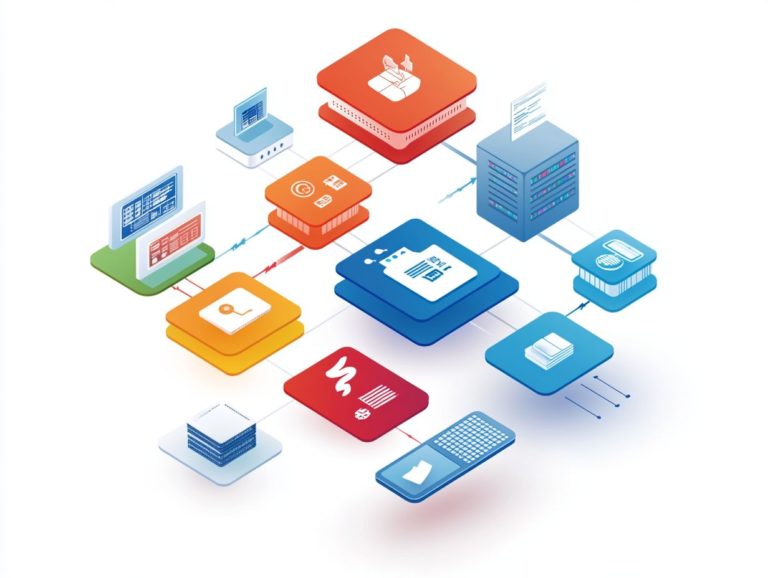How to Implement Cloud DevSecOps?
In today s fast-paced digital landscape, integrating security into your development and operations processes is essential. Cloud DevSecOps merges development, security, and operations, resulting in enhanced security and improved efficiency.
Get ready to discover the key benefits of Cloud DevSecOps! This article outlines the fundamental components that contribute to its effectiveness and the steps necessary for successful implementation.
It will also address common challenges you may encounter and offer best practices to ensure a smooth transition. By the end, you will possess a comprehensive understanding of how to navigate your Cloud DevSecOps journey with confidence.
Contents
- Key Takeaways:
- Understanding the Basics
- Benefits of Implementing Cloud DevSecOps
- Key Components of Cloud DevSecOps
- Steps to Implement Cloud DevSecOps
- Challenges and Solutions for Implementing Cloud DevSecOps
- Best Practices for Successful Implementation
- Preguntas Frecuentes
- FAQ: Qu es Cloud DevSecOps y por qu es importante?
- FAQ: Cu les son los principios clave para implementar Cloud DevSecOps?
- FAQ: C mo puedo empezar a implementar Cloud DevSecOps en mi organizaci n?
- FAQ: Cu les son los desaf os comunes de implementar Cloud DevSecOps?
- FAQ: C mo puede Cloud DevSecOps beneficiar a mi organizaci n?
- FAQ: Existen mejores pr cticas para implementar Cloud DevSecOps?
Key Takeaways:

Implementing Cloud DevSecOps improves security and efficiency in your system.
Automation, collaboration, and monitoring are key components of Cloud DevSecOps.
To successfully implement Cloud DevSecOps, assess your current system, identify and address gaps, and implement tools and processes.
Understanding the Basics
Understanding the fundamentals of Cloud DevSecOps is crucial for organizations that aim to bolster their security posture while preserving agility in the development lifecycle.
By integrating security into the Continuous Integration and Continuous Deployment (CI/CD) pipeline and utilizing tools such as Terraform, you can enhance your application deployments on Google Cloud. This comprehensive approach ensures that various security controls like threat modeling and secure design practices are woven throughout the lifecycle. This effectively reduces vulnerabilities and aligns with industry compliance standards.
This integration enhances the traditional DevOps framework and cultivates a culture of shared responsibility, where development, operations, and security teams collaborate closely.
This collaborative environment enables you to implement robust security measures right from the start of the software development lifecycle, allowing for faster identification and remediation of security issues.
As a result, cloud-native tools such as Docker and Kubernetes become invaluable, serving not just for deployment but also for real-time monitoring and maintaining security compliance.
By adopting these practices, your organization will find its systems more resilient, agile, and capable of swiftly responding to emerging threats, ultimately elevating the effectiveness of your cloud strategies.
Benefits of Implementing Cloud DevSecOps
Implementing Cloud DevSecOps brings a wealth of benefits that elevate both security and efficiency in your application development and deployment processes, especially when you know how to implement cloud security best practices.
You can enhance your security posture with continuous automation, proactively defending against threats such as DDoS attacks while ensuring compliance with security standards.
This integrated framework fosters greater business agility and reduces costs by streamlining processes within your CI/CD pipeline. It s a strategic move that aligns security with speed, allowing you to innovate with confidence.
Improved Security and Efficiency
Improved security and efficiency are essential outcomes when you implement DevSecOps in a cloud environment. By streamlining your security controls, you can significantly reduce vulnerabilities.
When you adopt automation tools, you can proactively tackle potential threats from malicious actors and elevate the overall security posture of your applications. For example, integrating CI/CD pipelines with security measures allows your code to be automatically scanned for vulnerabilities before it reaches production.
Tools like Snyk help you identify open-source vulnerabilities early in the development process, enabling your teams to resolve issues without sacrificing productivity. Managing infrastructure through code (IaC) allows you to enforce security policies uniformly across environments, minimizing the risk of human error.
These practices accelerate your development cycles and cultivate a culture of accountability, ultimately leading to a more resilient and secure application ecosystem.
Take action now to implement these strategies and enhance your organization’s security and efficiency. Check out additional resources to further your Cloud DevSecOps knowledge!
Key Components of Cloud DevSecOps
The essential components of Cloud DevSecOps revolve around automation, collaboration, and continuous monitoring. This ensures that security is woven seamlessly throughout the software development lifecycle.
By harnessing cloud-centric tools such as Google Cloud s Security Command Center (SCC) and Cloud Armor, you can automate security checks while promoting collaboration among your development, security, and operations teams. This approach boosts your security, making it a key part of your software development.
Automation, Collaboration, and Monitoring

Automation, collaboration, and monitoring are crucial for successfully implementing Cloud DevSecOps. They enable you to efficiently manage security controls while maintaining top-tier performance.
By automating security assessments through Continuous Software Development Lifecycle (SDL) and encouraging collaboration across teams, you must act now to mitigate risks and elevate your overall security stance.
Automation simplifies repetitive tasks like vulnerability scanning and compliance checks. This minimizes human error and frees your team to focus on more strategic initiatives.
Collaboration is vital; promoting communication among development, operations, and security teams significantly decreases the likelihood of security gaps.
Monitoring offers real-time insights into your system’s security landscape, enabling you to respond quickly to emerging threats. Each of these elements works together to create a robust framework that prioritizes security and enhances operational efficiency.
Steps to Implement Cloud DevSecOps
Implementing Cloud DevSecOps demands a structured strategy that emphasizes a series of steps to seamlessly weave security into your CI/CD pipeline. Begin by evaluating your existing systems and practices, pinpointing any gaps that may exist, as understanding the role of DevSecOps in cloud security is crucial for this process.
Next, focus on integrating the necessary tools and processes. This could involve providing security training for your teams, cultivating a culture of risk management and heightened security awareness. By taking these thoughtful steps, you position your organization to thrive in a secure cloud environment.
Assessing Your Current System
Assessing your current system is the crucial first step in implementing Cloud DevSecOps. This allows you to evaluate your existing security posture and identify potential vulnerabilities.
Review your current practices, the tools in use, and compliance with security standards to find vulnerabilities. A thorough audit of your infrastructure is essential to identify which assets are at risk and how they compare to industry benchmarks.
In tandem with this audit, conducting vulnerability scans and penetration testing will provide you with a detailed understanding of weaknesses within your system. Using tools that test your application for security issues during development and after deployment can clarify areas needing immediate attention.
Assessing regulatory compliance not only helps you pinpoint legal risks but also highlights necessary improvements. This sets the stage for a well-integrated DevSecOps methodology that enhances both your security and agility.
Identifying and Addressing Gaps
After assessing your current system, the next crucial step is to identify and address gaps in your security controls and compliance practices. This involves analyzing the vulnerability data collected during the assessment phase and prioritizing the areas posing the greatest risk to your organization s security.
To effectively pinpoint these vulnerabilities, conduct rigorous audits and leverage penetration testing to uncover weak points within your infrastructure. By employing a risk-based approach, you can categorize vulnerabilities based on their potential impact and likelihood of exploitation, allowing for a more strategic allocation of resources.
Regularly reviewing regulatory frameworks related to your industry is essential to ensure compliance measures are consistently met. Engaging with advanced threat intelligence can also provide valuable insights into emerging risks, helping you stay ahead of cyber threats and fortify your defenses.
Implementing Tools and Processes
Implementing the right tools and processes is vital for seamlessly integrating a secure development process that uses cloud technology into your organization s workflow. This significantly enhances both security and efficiency.
Solutions like Terraform for infrastructure as code and Google Cloud Armor for network security are instrumental in establishing robust security controls. They also streamline the deployment and management of your applications.
Utilizing tools such as Jenkins for Continuous Integration and Continuous Delivery (CI/CD) enables your teams to automate deployment processes. This ensures that software is delivered more swiftly and with fewer bugs.
When paired with container orchestration platforms like Kubernetes, you can further strengthen application management by automating scaling and optimizing resource efficiency.
Incorporating security testing tools like Snyk allows you to identify vulnerabilities early in the development cycle. This enables your developers to tackle potential issues proactively.
These tools bolster your security measures and foster an agile development environment that adapts effortlessly to evolving needs.
Challenges and Solutions for Implementing Cloud DevSecOps

Implementing Cloud DevSecOps can pose challenges that you must adeptly navigate to truly harness the advantages of a secure development lifecycle, including understanding how to implement cloud governance.
You may encounter common obstacles such as resistance to change among team members, a lack of sufficient security training, and inadequate threat modeling practices. Addressing these issues strategically is essential.
Overcoming Common Obstacles
Overcoming common obstacles in Cloud DevSecOps implementation calls for a proactive approach that emphasizes collaboration. Enhanced security training within your teams is crucial.
By fostering a culture of shared responsibility for security and implementing regular training sessions, you can build resilience against vulnerabilities. This elevates your overall risk management strategies.
Establishing cross-functional teams that integrate developers, security professionals, and operations staff breaks down silos and encourages open communication. This gives everyone a clearer understanding of security practices throughout the development lifecycle.
Utilizing tools that automate compliance checks and incorporate security testing early in the development process helps streamline your workflows. This ensures that security protocols are consistently applied.
Regular feedback loops and knowledge-sharing sessions promote a culture where team members feel empowered to address security issues proactively. This ultimately contributes to a more robust and secure DevSecOps environment.
Best Practices for Successful Implementation
By adopting best practices for the successful implementation of Cloud DevSecOps, you can significantly enhance your organization s security posture while ensuring efficient application delivery.
Focus on integrating security controls seamlessly into your CI/CD pipeline, leveraging automation to boost efficiency, and cultivating a culture of continuous improvement among your teams.
This approach supercharges your security and streamlines your development processes, setting the stage for sustained success.
Tips for Ensuring Success
To achieve success in implementing Cloud DevSecOps, you should encourage teamwork among your development, security, and operations teams. For a deeper understanding of this approach, explore what Cloud DevOps is. Continuously evaluating your security status is vital.
Regular updates to security training and adapting to emerging vulnerabilities will help you maintain a robust defense against evolving threats. Using automation tools streamlines your workflows, so teams can quickly identify vulnerabilities and share insights.
Encouraging open communication through regular meetings can bridge gaps between departments. This cultivates a culture of shared responsibility for security.
Integrating security into every phase of the development cycle enhances your responsiveness to threats. By leveraging cloud-native services, you’ll be able to deploy real-time monitoring more effectively and adjust your strategies as needed.
Ultimately, a proactive approach that prioritizes adaptability and collaboration will lead to sustainable success and a more resilient infrastructure. This enables your organization to thrive in an increasingly complex digital landscape. Start transforming your security approach today, and watch your organization thrive!
Preguntas Frecuentes
FAQ: Qu es Cloud DevSecOps y por qu es importante?

Cloud DevSecOps combina desarrollo, seguridad y operaciones para asegurarse de que la seguridad sea parte del proceso de desarrollo. Es importante porque asegura que la seguridad no sea un pensamiento posterior, sino un aspecto continuo del proceso de desarrollo.
FAQ: Cu les son los principios clave para implementar Cloud DevSecOps?
Los principios clave para implementar Cloud DevSecOps son la automatizaci n, la colaboraci n y la monitorizaci n continua. La automatizaci n ayuda a agilizar los procesos y reducir errores. La colaboraci n asegura que todos los miembros del equipo participen en el proceso de seguridad. La monitorizaci n continua permite la identificaci n y resoluci n r pida de cualquier problema de seguridad.
FAQ: C mo puedo empezar a implementar Cloud DevSecOps en mi organizaci n?
La mejor manera de comenzar a implementar Cloud DevSecOps es realizar una evaluaci n de seguridad exhaustiva para identificar vulnerabilidades existentes. Luego, establece un equipo multifuncional y define roles y responsabilidades para cada miembro del equipo. Finalmente, implementa herramientas y procesos de automatizaci n para integrar la seguridad en el proceso de desarrollo.
FAQ: Cu les son los desaf os comunes de implementar Cloud DevSecOps?
Algunos desaf os comunes de implementar Cloud DevSecOps incluyen la resistencia al cambio, la falta de colaboraci n entre equipos, y la falta de conocimientos y habilidades en pr cticas de seguridad. Es importante abordar estos desaf os proporcionando capacitaci n y recursos adecuados, y promoviendo una cultura de mejora continua y colaboraci n.
FAQ: C mo puede Cloud DevSecOps beneficiar a mi organizaci n?
Cloud DevSecOps puede beneficiar a tu organizaci n de m ltiples maneras, incluyendo mejorar la postura de seguridad, acelerar la entrega de aplicaciones seguras, reducir el riesgo de brechas de seguridad, y aumentar la colaboraci n y comunicaci n entre equipos. Tambi n ayuda a ahorrar tiempo y recursos al automatizar procesos de seguridad.
FAQ: Existen mejores pr cticas para implementar Cloud DevSecOps?
S , algunas mejores pr cticas para implementar Cloud DevSecOps incluyen realizar evaluaciones de seguridad regulares, automatizar procesos de seguridad, promover una cultura de mejora continua y colaboraci n, e integrar la seguridad en todo el proceso de desarrollo. Tambi n es importante mantenerse actualizado sobre las ltimas amenazas y tecnolog as de seguridad.





